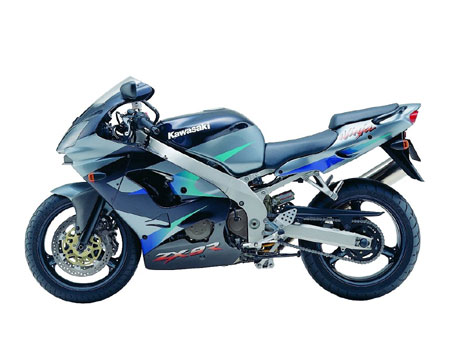
Back to 2001 Kawasaki Motorcycle Index Page
Click photo to enlarge.
It makes a great desktop image.
2001 Kawasaki Ninja Sportbikes
– 2001 Kawasaki Ninja ZX-9R
.
2001 KAWASAKI NINJA® ZX-9R
Combines Open-Class Performance
With Real-World Sport Riding Versatility
Kawasaki revolutionalized the big-bore sportbike class in 1984 when it released the original Ninja® 900. Since then Kawasaki has continually updated its Open-class Ninja motorcycle, and the 2001 ZX-9R features an engine that produces an abundance of heart-pumping power and strong acceleration in a lightweight, compact chassis for the ultimate sportbike experience.
The ZX-9R engine has a lightweight, all-aluminum cylinder block. Each oversquare cylinder bore has an electroplated lining that resists wear and improves heat dispersion. The cylinder head is shaped to provide a high compression ratio, while cam timing and the cam profile are designed for plenty of torque across the rev range.
Four Keihin 40mm downdraft carburetors deliver excellent throttle response and are equipped with the Kawasaki Throttle Responsive Ignition Control (K-TRIC) system. Linked to the ignition system, K-TRIC adjusts ignition timing for all throttle settings. A 16-bit microprocessor accurately adjusts timing from sensors at both the carburetors and the crankshaft.
The carburetors breathe through Kawasaki’s Ram Air system that has a large intake duct for maximum intake efficiency. A right-side cam drive allows an extremely tight angle for the direct-actuation valves to further enhance intake efficiency.
The four-into-two-into-one exhaust system features a lightweight, all-titanium muffler with the Kawasaki Clean Air System catalyzer, except for California models that have a stainless steel unit and an additional catalyzer for reduced emissions. The catalyzer allows the engine to be tuned for maximum performance since the catalyzer reduces emissions downstream.
The short-wheelbase aluminum frame has wide spars and a long steering head pipe for rigidity and remarkable handling. An aluminum sub-frame is detachable for easy access to the rear suspension.
The extruded aluminum swingarm features a hexagonal structure with ribbing for reduced weight and exceptional rigidity. Kawasaki’s Bottom Link UNI-TRAK® system has linkage ratios that provide a linear progression of damping and spring rates on the fully-adjustable single shock as the suspension is compressed. A ride height adjuster allows riders to fine-tune the chassis to suit specific conditions. Up front the 46mm cartridge fork has damping settings to match the stiff chassis and rear suspension settings.
Dual front disc brakes have large-diameter 310mm semi-floating discs clamped by opposed six-piston calipers, while the rear brake holder is designed to save weight. The rear wheel has a six-inch wide rim that allows a wide rear tire for better traction, while both front and rear axles have a large diameter and are hollow for increased rigidity and light weight.
The ZX-9R slips through the wind with its fairing that incorporates race-proven aerodynamics. Dual “cat eye” multi-reflector headlights enhance the ZX-9R’s aggressive styling. Below the windscreen is a compact electronic speedometer/odometer with LCD display driven by sensors located on the countershaft sprocket.
The original Ninja 900 established the standard by which sportbikes of the 20th century were judged. With its advanced features and performance, the 2001 Ninja ZX-9R ensures that the new standard for the 21st century bears the Kawasaki name.
2001 NINJA® ZX-9R FEATURES
899cc, High-Compression Four-Cylinder Engine
Aluminum electroplated cylinder is light, resists wear and improves heat dispersion
Large bore with ultra-short stroke maximizes valve diameters for powerful breathing and minimizes piston speed for reliability
Four large valves per cylinder are activated by bucket tappets for the ultimate in high rpm reliability
Compact design lowers weight and allows more room for intake, exhaust, and cooling systems
The alternator is at the end of the crankshaft to save weight and cut mechanical friction losses; rare earth magnets in the alternator are very powerful for efficient charging, but light in weight
Magnesium covers are used on the cylinder head, clutch, alternator, ignition pickups, and the engine sprocket
Titanium muffler case is used on “49-state” models
Catalytic Converter
Catalytic converter reduces exhaust emissions while allowing full power output
Pre-converter is hidden in the exhaust pipe, main converter is in the muffler so nothing shows (CA model)
49-state models have a converter in the exhaust pipe
Kawasaki Throttle Responsive Ignition Control (K-TRIC)
A throttle position sensor tells the ignition control unit how hard the engine is working so that its new 16-bit micro-computer can determine the best ignition timing for more power and better fuel economy
Spark Plug-Mounted Ignition Coils
Four small ignition coils are in the spark plug caps, reducing overall weight and taking up less room
Liquid Cooling
The automatic fan is offset to the left behind the curved radiator to save space and keep the engine cooler in various conditions
The temperature gauge reads in actual degrees and includes an LED warning light
Six-Speed Transmission
Involute spline shafts decrease shift effort
The cable operated clutch has a smooth, light feel, and weighs less than a hydraulic unit
Lightweight Aluminum Perimeter Frame
The frame has no down tubes to save weight
Lightweight removable aluminum sub-frame
Extruded Aluminum Swingarm
Massive extruded aluminum beams are welded together to form a swingarm with extra rigidity and less weight for good handling under extreme conditions
46mm, Fully-Adjustable, Conventional Cartridge-Type Front Fork/Fully Adjustable Rear Shock
Front fork is light-weight for high performance, compliant for rider comfort, and rigid for extraordinary handling
Adjustable spring preload, and compression and rebound damping to match rider weight and riding style to the road conditions
Light Weight Disc Brakes
Minimize unsprung weight, for sharp, precise handling
Tokico 6-piston calipers up front maximize effective disc diameter for precise, powerful brake feel
All Electric Instrumentation
Electric tachometer, speedometer are compact and lightweight
LCD clock, odometer, trip meter, and coolant temperature gauge with LED warning light
2001 KAWASAKI NINJA® SPORTBIKES
Built to Deliver Performance
For years Kawasaki NINJA® motorcycles have defined the sportbike market and represented the company’s long-standing performance heritage. The 2001 Kawasaki NINJA motorcycle line-up gives motorcyclists a variety of ways to experience Kawasaki’s legendary performance, from the most powerful NINJA ever to entry-level models that can still deliver plenty of thrills to seasoned veterans.
The NINJA ZX-12R is the flagship model in the NINJA motorcycle line-up and is the most radical embodiment of race-proven technology that Kawasaki has ever produced. Quite simply, the ZX-12R was built to deliver the lightest weight and highest power-to-weight ratio of any machine in its class.
The very first NINJA was a 900cc machine, and the ZX-9R carries on the tradition of providing open-class power in a lightweight, nimble package. This is the model that became the first production motorcycle to break the nine-second barrier in the enthusiast magazines’ quarter-mile testing.
In recent years Kawasaki has dominated the AMA/Prostar Motorcycle Drag Racing Series, with Kawasaki Drag Racing’s Rickey Gadson winning three consecutive AMA/Prostar 750 Superbike National Championships, and teammate Marty Ladwig winning the 1999 600cc SuperSport title.
Kawasaki Road Racing uses the NINJA ZX-7R as the base for its AMA U.S. Superbike Championship assault and it has carried team rider Eric Bostrom to victory. Bostrom also won on the NINJA ZX-6R that kept him
near the top of the 2000 600cc SuperSport Series all season long. The ZX-6R has also been highly acclaimed in the enthusiast press, winning several 2000-model 600cc sportbike comparisons and being chosen “Best Middleweight Streetbike” in Cycle World magazine’s annual Ten Best Bikes feature.
For those looking for NINJA performance at an economical price, Kawasaki has three models. The NINJA ZX-6 features SuperSport championship-winning performance in an extremely comfortable and user-friendly package, while the NINJA 500R and 250R models provide excellent entries to the NINJA motorcycle fold.
No matter which NINJA motorcycle it is, customers can always count on getting a motorcycle that performs.
Specifications:
Model
Ninja ZX900-E2
Engine Type
4-stroke, liquid-cooled oil cooler
Displacement
899 cc.
Bore x Stroke
75 x 50.9 mm.
Compression Ratio
12.2:1
Valve System
DOHC, 16 valves
Carburetion
Keihin CVRD40 x 4
Ignition
Digital
Starting
Electric
Transmission
6-speed
Frame type
Perimeter, pressed aluminum
Rake / Trail
24 degrees
Wheelbase
55.7″
Suspension, Front
46 mm. fully adjustable cartridge fork with adjustable preload
Suspension, Rear
Bottom-Link Uni-Trak
Tire Front
120/70ZR17
Tire Rear
190/50ZR17
Brakes, Front
Dual 310 semi-floating disc with dual six-piston calipers
Brakes, Rear
Disc with single-piston caliper
Seat Height
31.9″
Fuel Capacity
5.0 gallons
Dry Weight
403.5 pounds
Specifications are subject to change without notice, in accordance with national regulation and legislations.



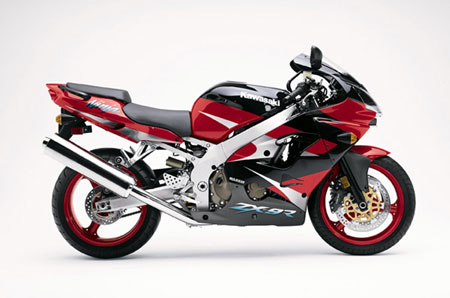
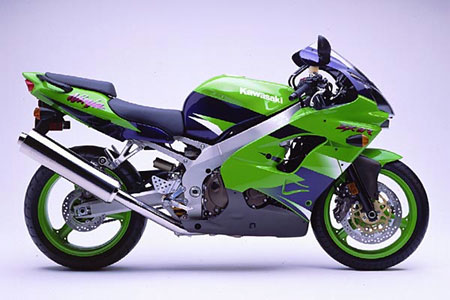
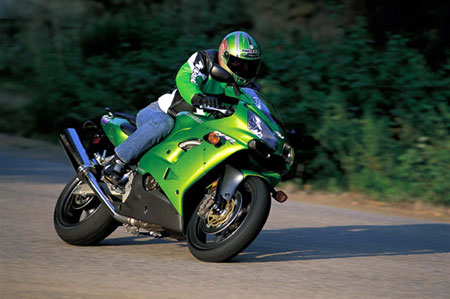
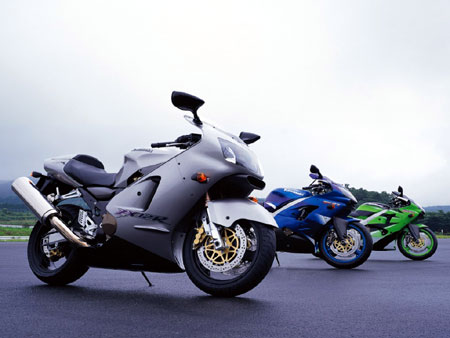

Be the first to comment